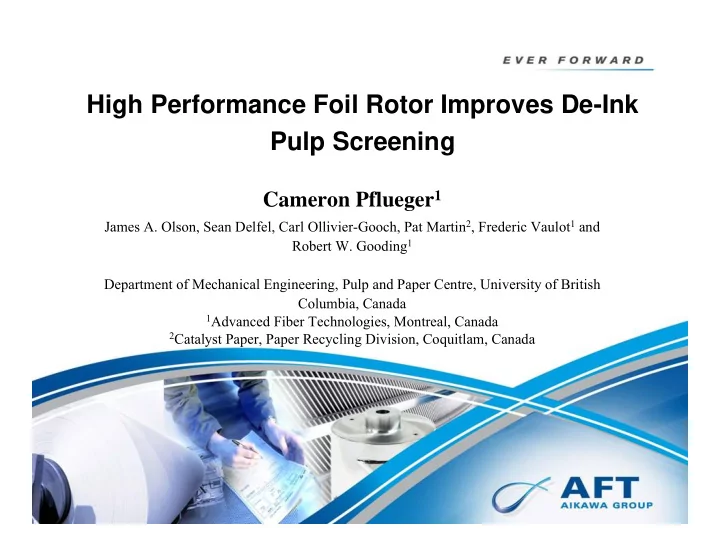

High Performance Foil Rotor Improves De-Ink Pulp Screening Cameron Pflueger 1 James A. Olson, Sean Delfel, Carl Ollivier-Gooch, Pat Martin 2 , Frederic Vaulot 1 and Robert W. Gooding 1 Department of Mechanical Engineering, Pulp and Paper Centre, University of British Columbia, Canada 1 Advanced Fiber Technologies, Montreal, Canada 2 Catalyst Paper, Paper Recycling Division, Coquitlam, Canada
Our Goal To help our customers by: • enhancing pulp quality (efficiency / fractionation) • increasing capacity • reducing power consumption • reducing the overall cost of pulp screening
Pulp Screening Basics � Pressure screens are essential for contaminant removal and fibre fractionation � Cylinders and rotors are the key performance parameters
Nomenclature Positive Peak, P max P Pressure Coefficient: = C ρ 2 P 1 V 2 t P = Power Consumption: C Pulse Width Power ρ 3 D 2 V t Negative Peak, P min
Previous Work 0.1 0.0 Perssure Coefficient, Cp -0.1 -0.2 -0.3 NACA 0012 (0% Camber) NACA 4312 (4% Camber) -0.4 NACA 8312 (8% Camber) -0.5 -0.6 -1 0 1 2 Position, x/Chord Wall Cp vs. foil camber (numerical, Feng et al. 2005 ).
CFD Single foil
CFD Single foil P = C ρ 2 P 1 V 2 t Wall Cp vs. angle-of-attack for a NACA 0012 foil (numerical, Feng et al. 2005 ).
New Developments Foil Parameters Studied: � Angle-of-attack ( α ) � Flap Angle ( δ ) � Flap positioning Canadian Forces C-130 Anderson, 1991
Results Flap angle was varied at a constant α : δ = 7°:
Results Flap angle was varied at a constant α : δ = 15°:
Results Flap angle was varied at a constant α : δ = 22°:
Results Flap angle was varied at a constant α : δ = 29°:
Results Flap angle was varied at a constant α : δ = 36°:
Results The α - and δ - sweep data was combined to create surfaces of max. and min. wall C P . Min. C P vs. α and δ . The ‘x’ marks the optimum of C P = -0.82 at α = 1.2 deg. and δ = 16 deg.
Results Surfaces were constructed of min. and max. wall C P vs. x- and y- position of the flap LE: Min. C P vs. x and y positions of the flap LE. The optimum of C P = -0.82 is at x = -0.05*c and y = -0052*c.
Mill Trial – De-Ink Fine Screen
Mill Trial – De-Ink Fine Screen Catalyst Paper, Paper Recycling Division Flowsheet
Mill Trial – De-Ink Fine Screen 55 50 45 Power (kW) 40 35 42% 30 25 20 DEF Rotor OEM Rotor 15 10 11 12 13 14 15 16 17 Tip Speed (m/s)
Mill Trial – De-Ink Fine Screen 2.0 Thickening Factor 1.8 1.6 DEF Rotor 1.4 OEM Rotor 1.2 1.0 12 13 14 15 16 17 Tip Speed (m/s)
Mill Trial – De-Ink Fine Screen 80% Stickies Removal Efficiency DEF Rotor 70% OEM Rotor 60% 50% 40% 12 13 14 15 16 17 Tip Speed (m/s)
Mill Trial – De-Ink Fine Screen Area 2 OEM Rotor DEF Rotor Count 1 100% 80% 60% 40% 20% 0% Stickies Removal Efficiency
Mill Trial – De-Ink Fine Screen 8 Accept Stickies Concentration 7 (number per gram) 6 OEM Rotor 5 DEF Rotor 4 3 2 1 0 < 0.21 0.3 0.4 0.5 0.75 1 1.5 2 2.5 3 Stickies Distribution (mm 2 )
Conclusions � Multi-element foil technology allows for greater control of pressure pulse. • Wider, stronger pulse can be obtained � Reducing Rotor Speed Increases Stickies Removal Efficiency � Power savings of 42% have been shown thus far with equivalent OEM rotor capacity � Preliminary mill trials extremely promising.
Questions? Thank you!
Recommend
More recommend